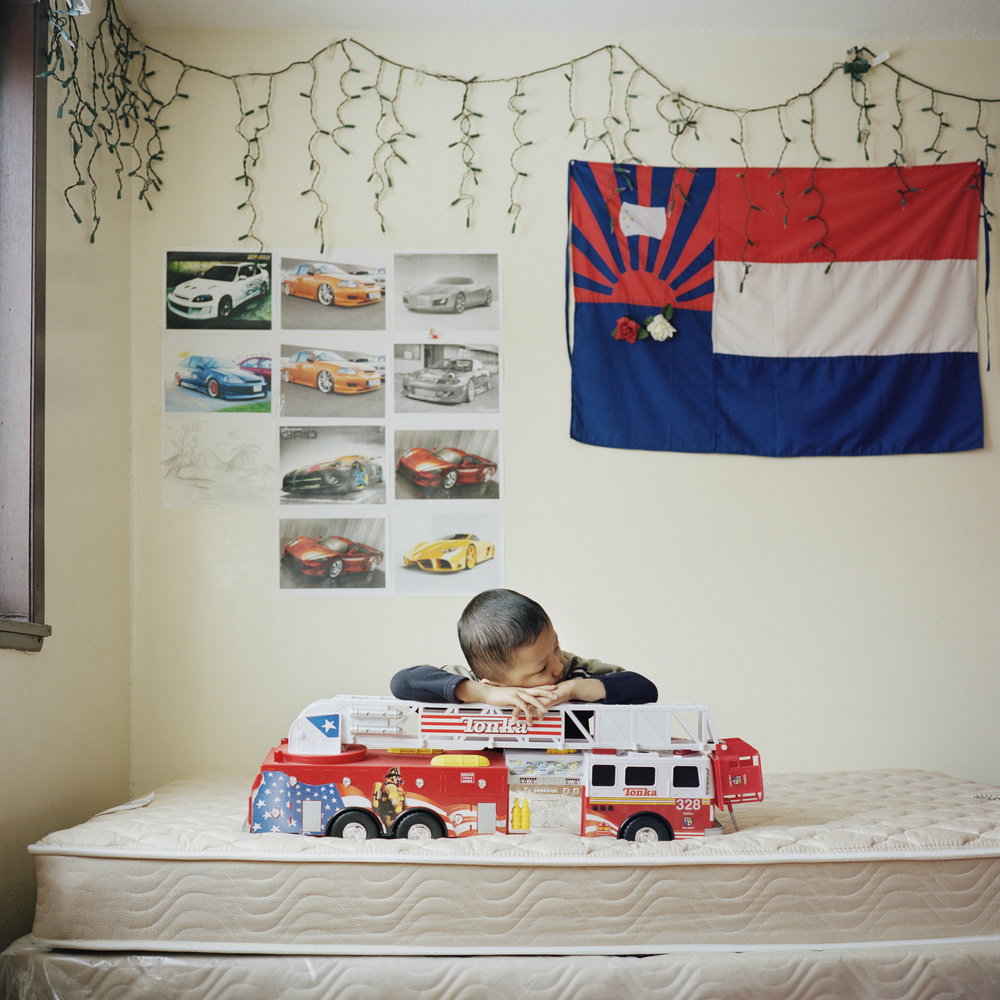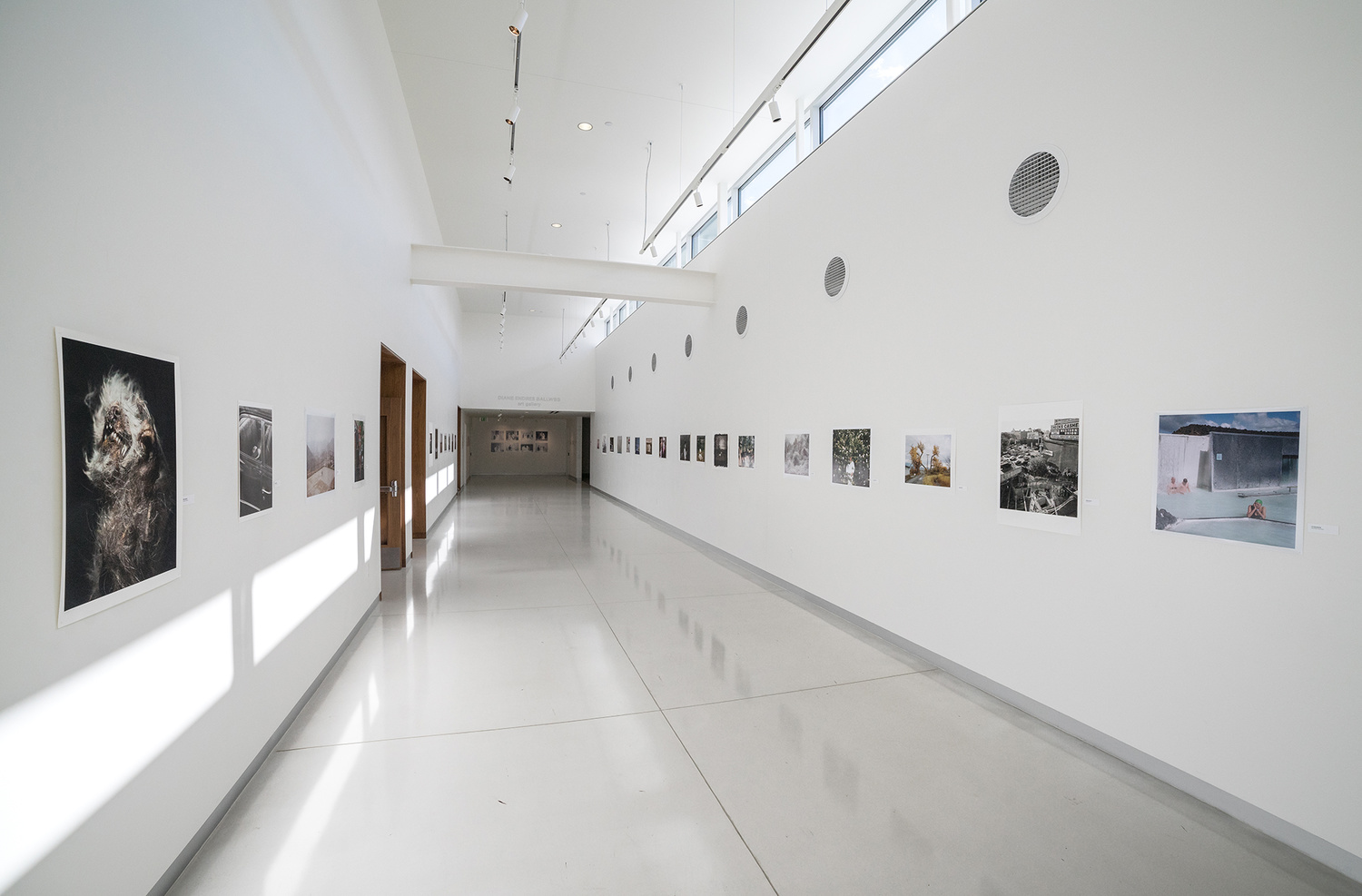In conjunction with The Bubbler and the Diane Endres Ballweg Gallery of the Madison Public Library, Andy Adams of FlakPhoto has produced a new photo exhibition called the Midwest Print Show. The show features 41 photographers living and working in the Midwestern United States, and includes a variety of subject matter from across the region.
The show officially opened on September 26, 2014 and will continue through October 30, 2014. Given that the Society for Photographic Education Midwest Conference is set to happen in Madison this month, Adams decided to take advantage of the happenings and produce a show that celebrates photographic prints from Midwestern photographers.

Photo by Alan Thomas.
Given that FlakPhoto is online and digital, what inspired you to organize a show of printed images? It seems like a bit of a departure from your previous focus with digital imagery and promotion.
It definitely is. I’ve been publishing FlakPhoto for nearly a decade and my goal has always been to build a better website. But, you’ve got to try new things — I’ve juried print exhibitions for many photography organizations but never independently produced my own and that was an exciting challenge. The Society for Photographic Education Midwest Conference will take place at the University of Wisconsin-Madison campus October 16-18, 2014 and that weekend is designed so people can share their passion for pictures together. Lots of Midwestern photographers will be in Madison for the proceedings and a print show seemed the perfect occasion to look at pictures together in person. In a way, I produced this show so people could socialize in the presence of photography.
How important is printing a photograph to the practice of modern photography?
What a lot of people don’t know is that I spent several years working at the Wisconsin Historical Society Visual Materials Archives — digitizing the photo collections and making print reproductions. That experience instilled a deep reverence in me for the thingness of photography and the role that photographic prints play in the greater history of the medium. Physical photographic objects last — and that’s extremely important. Prints are probably more vital now than they’ve ever been since many images never materialize in physical form. The craft of photographic printmaking is alive and well and the FlakPhoto Midwest Print Show is an opportunity to celebrate that tradition on a local level.

Photo by Annick Sjobakken.
Most shows charge an entry fee; many charge large entry fees. You didn’t. Could you explain a bit about why it was free to enter the FlakPhoto show?
My work is focused on helping photographers get their work out into the world and I’d prefer not to charge them a fee to submit to my shows if I don’t have to — I’m happy they’re interested in collaborating with me! We were able to secure some small funding from the National Endowment for the Arts to produce the show and kept costs down by exhibiting unframed prints. This is a purely creative endeavor — not a moneymaking scheme. It’s about showcasing the variety of talent based here in the American Midwest.

Photo by Jason Vaughn.
A large part of your lectures & presentations revolve around the idea that a web browser (online exhibition of the work) isn’t significantly different from offline presentation — in this case, the print show. Social media allows us all to access new online work quickly, and potentially find a community of like-minded people. Do you foresee the FlakPhoto show fostering the same type of discussion and community?
For the past few years my projects have emphasized digital exhibitions designed for global, web-based audiences but I’ve never produced anything locally and I’m interested in growing the photo community where I live. Social media played a big role in raising awareness about the exhibition and the creative community came together to spread the word. More than 450 people came out for the opening and people have actually stopped me on the street to comment on the show — there’s not a huge photo scene here it’s exciting to make that impact.
How do you envision the online aspect of the show coming together?
We’re in the process of producing a website companion to the print show so we can share the work of these imagemakers with the world outside of Madison, Wisconsin. My previous museum exhibitions have been digital-first projects that emphasize the image as the primary photographic experience. In this case, the website is a complement to the print show that stands on its own — spectators can access the site on their mobile devices to read photographer biographies and learn more about the artists by linking to their websites. This project is a true hybrid exhibition — it lives simultaneously on and offline. My goal here is to leverage the internet to share these photographers with the wider world of photography enthusiasts — people who might not otherwise have an opportunity to discover their work. The images function across platforms — in print and onscreen.

Photo by Peter Baker.
I quite like that half of your main objective for this show is putting "Midwestern photo people” together in the same space; allowing interaction with the prints and each other at the same time. It’s so different than 500 people hitting a webpage to view a photo for a minute or two, then moving onto another site to read the news, Facebook, etc. You are processing your own reaction to the work, while observing and processing the other attendants’ reactions at the same time.
Definitely. I gave a gallery talk last week and it was a ton of fun - mainly because all of us had this opportunity to talk with each other about the pictures we were looking at together. That’s obvious when you think about it but it’s certainly one of the aspects that’s missing from the online photographic experience. There’s a unique pleasure in sharing a conversation about a picture with another person.
Can you explain the choice to show unframed work?
I partnered with the BUBBLER at Madison Public Library to present this show — the BUBBLER is a wonderful maker space where I live in Madison, Wisconsin and their mission is focused on producing creative work out of anything. The idea of an unframed print show fit perfectly into that philosophy. I also decided early on that I wanted our photographers to produce their own prints — that the show should feature the uniqueness of each of their particular printing styles and paper preferences. That meant that 40+ photographers needed to ship their work to Madison affordably and efficiently. After we got the prints on the walls I realized how beautiful they were without being obscured by matting, framing and glass. It’s just you and the image without those other distractions — which is very much how pictures look on the FlakPhoto website. It’s FlakPhoto IRL.

Photo by Selma Fernandez Richter.
Your 100 Portraits - 100 Photographers show included some real heavy-hitters in the fine art photography community. Besides the obvious geographic restriction, how does limiting the show to photographers both living and working in the Midwest impact the show?
It definitely gives the show a unique sense of local character — and reinforces a kind personal pride in the spectator. In America, there’s this idea that the best photographers are on the coasts — in New York City or Los Angeles. But there’s something unique about the middle of the country — the pace and rhythms are different and that dynamic lends itself to a particular kind of creative life. There’s an enormous amount of talent here in the Midwest and, for those of us who live here, it feels good to remind ourselves of that. This is a special part of the world and we’re proud of it.

Photo by Jenn Ackerman and Tim Gruber.
All images in this article were provided by FlakPhoto, and are currently being shown as part of the Midwest Print Show. For more information on the individual photographers, please check out these links: Alan Thomas, Annick Sjobakken, Jason Vaughn, Ackerman+Gruber, Peter Baker, Selma Fernandez Richter.
Andy Adams is an independent producer + publisher whose work blends aspects of digital communication, online audience engagement, and web-based creative collaboration to explore current ideas in photography and visual media.
Recent projects include The Future of Photobooks, a cross-blog conversation that considered the impact of internet culture on photographic production, exhibition and distribution and 100 Portraits — 100 Photographers, an exhibition of contemporary portraiture that has shown at the Corcoran Gallery of Art, the Australian Centre for Photography and numerous festivals in the U.S. and abroad. In 2012, he was commissioned by the Museum of Art, Rhode Island School of Design to produce Looking at the Land — 21st Century American Views, a web-based survey exploring the evolving landscape photographic tradition. Last year, Adams partnered with the Nelson-Atkins Museum of Art to produce Making Pictures of People, a mobile publication/exhibition of recent photographic portraiture designed for touchscreen tablets and handheld devices.
He is the editor of FlakPhoto, a website that promotes the discovery of photographic image-makers from around the world. In his spare time he hosts the FlakPhotoNetwork, an online community focused on conversations about photo/arts culture.
Adams was recently named by eyefi as one of the Top 30 Most Socially Influential Photographers.

Photo by Ryan Mense.






